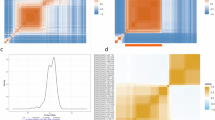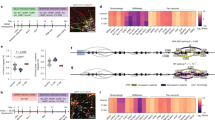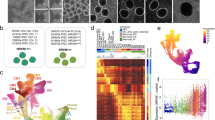Abstract
Neurexins are presynaptic neuronal adhesion molecules that interact with postsynaptic neuroligins to form an inter-synaptic complex required for synaptic specification and efficient neurotransmission. Deletions and point mutations in the neurexin 1 (NRXN1) gene are associated with a broad spectrum of neuropsychiatric and neurodevelopmental disorders, including autism, intellectual disability, epilepsy, developmental delay, and schizophrenia. Recently, small nucleotide polymorphisms in NRXN1 have been associated with antipsychotic drug response in patients with schizophrenia. Based on previous suggestive evidence of an impact on clozapine response in patients with schizophrenia, we conducted an association study of NRXN1 polymorphisms (rs12467557 and rs10490162) with antipsychotic treatment response in 54 patients with schizophrenia in a double blind, placebo-controlled NIMH inpatient crossover trial and examined for association with risk for schizophrenia in independent case-control and family-based clinical cohorts. Pharmacogenetic analysis in the placebo controlled trial revealed significant association of rs12467557and rs10490162 with drug response, whereby individuals homozygous for the A allele, at either SNP, showed significant improvement in positive symptoms, general psychopathology, thought disturbance, and negative symptoms, whereas patients carrying the G allele showed no overall response. Although we did not find evidence of the same NRXN1 SNPs being associated with results of the NIMH sponsored CATIE trial, other SNPs showed weakly positive signals. The family and case-control analyses for schizophrenia risk were negative. Our results provide confirmatory evidence of genetically determined differences in drug response in patients with schizophrenia related to NRXN1 variation. Furthermore, these findings potentially implicate NRXN1 in the therapeutic actions of antipsychotic drugs.
Similar content being viewed by others
Log in or create a free account to read this content
Gain free access to this article, as well as selected content from this journal and more on nature.com
or
References
Apud JA, Zhang F, Decot H, Bigos KL, Weinberger DR (2012). Genetic variation in KCNH2 associated with expression in the brain of a unique hERG isoform modulates treatment response in patients with schizophrenia. Am J Psychiatry 169: 725–734.
Bassett AS, Marshall CR, Lionel AC, Chow EW, Scherer SW (2008). Copy number variations and risk for schizophrenia in 22q11.2 deletion syndrome. Hum Mol Genet 17: 4045–4053.
Bena F, Bruno DL, Eriksson M, van Ravenswaaij-Arts C, Stark Z, Dijkhuizen T et al (2013). Molecular and clinical characterization of 25 individuals with exonic deletions of NRXN1 and comprehensive review of the literature. Am J Med Genet B Neuropsychiatr Genet 162B: 388–403.
Bierut LJ, Madden PA, Breslau N, Johnson EO, Hatsukami D, Pomerleau OF et al (2007). Novel genes identified in a high-density genome wide association study for nicotine dependence. Hum Mol Genet 16: 24–35.
Bigos KL1, Bies RR, Pollock BG, Lowy JJ, Zhang F, Weinberger DR (2011). Genetic variation in CYP3A43 explains racial difference in olanzapine clearance. Mol Psychiatry 16: 620–625.
Bigos KL1, Pollock BG, Coley KC, Miller DD, Marder SR, Aravagiri M et al (2008). Sex, race, and smoking impact olanzapine exposure. J Clin Pharmacol 48: 157–165.
Chen X, Shen Y, Zhang F, Chiang C, Pillalamarri V, Blumenthal I et al (2013). Molecular analysis of a deletion hotspot in the NRXN1 region reveals the involvement of short inverted repeats in deletion CNVs. Am J Hum Genet 92: 375–386.
Dabell MP, Rosenfeld JA, Bader P, Escobar LF, El-Khechen D, Vallee SE et al (2013). Investigation of NRXN1 deletions: clinical and molecular characterization. Am J Med Genet 161: 717–731.
Docampo E, Ribases M, Gratacos M, Bruguera E, Cabezas C, Sanchez-Mora C et al (2012). Association of neurexin 3 polymorphisms with smoking behavior. Genes Brain Behav 11: 704–711.
Dudanova I, Sedej S, Ahmad M, Masius H, Sargsyan V, Zhang W et al (2006). Important contribution of alpha-neurexins to Ca2+-triggered exocytosis of secretory granules. J Neurosci 26: 10599–10613.
Duong L, Klitten LL, Moller RS, Ingason A, Jakobsen KD, Skjodt C et al (2012). Mutations in NRXN1 in a family multiply affected with brain disorders: NRXN1 mutations and brain disorders. Am J Med Genet B Neuropsychiatr Genet 159B: 354–358.
Fedorova L, Fedorov A (2003). Introns in gene evolution. Genetica 118: 123–131.
Giegling I, Balzarro B, Porcelli S, Schafer M, Hartmann AM, Friedl M et al (2013). Influence of ANKK1 and DRD2 polymorphisms in response to haloperidol. Eur Arch Psychiatry Clin Neurosci 263: 65–74.
Grayton HM, Fernandes C, Rujescu D, Collier DA (2012). Copy number variations in neurodevelopmental disorders. Prog Neurobiol 99: 81–91.
Hishimoto A, Liu QR, Drgon T, Pletnikova O, Walther D, Zhu XG et al (2007). Neurexin 3 polymorphisms are associated with alcohol dependence and altered expression of specific isoforms. Hum Mol Genet 16: 2880–2891.
Ikeda M, Yamanouchi Y, Kinoshita Y, Kitajima T, Yoshimura R, Hashimoto S et al (2008). Variants of dopamine and serotonin candidate genes as predictors of response to risperidone treatment in first-episode schizophrenia. Pharmacogenomics 9: 1437–1443.
Ikeda M, Aleksic B, Kirov G, Kinoshita Y, Yamanouchi Y, Kitajima T et al (2010). Copy number variation in schizophrenia in the Japanese population. Biol Psychiatry 67: 283–286.
International Schizophrenia Consortium (2008). Rare chromosomal deletions and duplications increase risk of schizophrenia. Nature 455: 237–241.
Kapur S, Mamo D (2003). Half a century of antipsychotics and still a central role for dopamine D2 receptors. Prog Neuropsychopharmacol Biol Psychiatry 27: 1081–1090.
Kay SR, Opler LA, Spitzer RL, Williams JB, Fiszbein A, Gorelick A (1991). SCID-PANSS: two-tier diagnostic system for psychotic disorders. Compr Psychiatry 32: 355–361.
Kirov G, Gumus D, Chen W, Norton N, Georgieva L, Sari M et al (2008). Comparative genome hybridization suggests a role for NRXN1 and APBA2 in schizophrenia. Hum Mol Genet 17: 458–465.
Kirov G, Rujescu D, Ingason A, Collier DA, O'Donovan MC, Owen MJ (2009). Neurexin 1 (NRXN1) deletions in schizophrenia. Schizophr Bull 35: 851–854.
Law AJ, Wang Y, Sei Y, O'Donnell P, Piantadosi P, Papaleo F et al (2012). Neuregulin 1-ErbB4-PI3K signaling in schizophrenia and phosphoinositide 3-kinase-p110delta inhibition as a potential therapeutic strategy. Proc Natl Acad Sci USA 109: 12165–12170.
Lett TA, Tiwari AK, Meltzer HY, Lieberman JA, Potkin SG, Voineskos AN et al (2011). The putative functional rs1045881 marker of neurexin-1 in schizophrenia and clozapine response. Schizophr Res 132: 121–124.
Lieberman JA, Stroup TS, McEvoy JP, Swartz MS, Rosenheck RA, Perkins DO et al (2005). Effectiveness of antipsychotic drugs in patients with chronic schizophrenia. N Engl J Med 353: 1209–1223.
Lotrich FE (2012). The emerging potential of pharmacogenetics in psychiatry. Am J Psychiatry 169: 681–683.
Malhotra AK, Zhang JP, Lencz T (2012a). Pharmacogenetics in psychiatry: translating research into clinical practice. Mol Psychiatry 17: 760–769.
Malhotra AK, Correll CU, Chowdhury NI, Müller DJ, Gregersen PK, Lee AT et al (2012b). Association between common variants near the melanocortin 4 receptor gene and severe antipsychotic drug-induced weight gain. Arch Gen Psychiatry 69: 904–912.
Missler M, Fernandez-Chacon R, Sudhof TC (1998). The making of neurexins. J Neurochem 71: 1339–1347.
Missler M, Zhang W, Rohlmann A, Kattenstroth G, Hammer RE, Gottmann K et al (2003). Alpha-neurexins couple Ca2+ channels to synaptic vesicle exocytosis. Nature 423: 939–948.
Moller RS, Weber YG, Klitten LL, Trucks H, Muhle H, Kunz WS et al (2013). Exon-disrupting deletions of NRXN1 in idiopathic generalized epilepsy. Epilepsia 54: 256–264.
Muhleisen TW, Basmanav FB, Forstner AJ, Mattheisen M, Priebe L, Herms S et al (2011). Resequencing and follow-up of neurexin 1 (NRXN1) in schizophrenia patients. Schizophr Res 127: 35–40.
Need AC, Keefe RS, Ge D, Grossman I, Dickson S, McEvoy JP et al (2009). Pharmacogenetics of antipsychotic response in the CATIE trial: a candidate gene analysis. Eur J Hum Genet 17: 946–957.
Nussbaum J, Xu Q, Payne TJ, Ma JZ, Huang W, Gelernter J et al (2008). Significant association of the neurexin-1 gene (NRXN1) with nicotine dependence in European- and African-American smokers. Hum Mol Genet 17: 1569–1577.
Owen MJ (2012). Implications of genetic findings for understanding schizophrenia. Schizophr Bull 38: 904–907.
Prathikanti S, Weinberger DR (2005). Psychiatric genetics—the new era: genetic research and some clinical implications. Br Med Bull 73-74: 107–122.
Ripke, Chambert K, Moran JL, Kähler AK, Akterin S, Bergen SE et al (2013). Genome-wide association analysis identifies 13 new risk loci for schizophrenia. Nat Genet 45: 1150–1159.
Rowen L, Young J, Birditt B, Kaur A, Madan A, Philipps DL et al (2002). Analysis of the human neurexin genes: alternative splicing and the generation of protein diversity. Genomics 79: 587–597.
Rujescu D, Ingason A, Cichon S, Pietilainen OP, Barnes MR, Toulopoulou T et al (2009). Disruption of the neurexin 1 gene is associated with schizophrenia. Hum Mol Genet 18: 988–996.
Shepard S, McCreary M, Fedorov A (2009). The peculiarities of large intron splicing in animals. PLoS One 4: e7853.
Snyder SH (1981). Dopamine receptors, neuroleptics, and schizophrenia. Am J Psychiatry 138: 460–464.
Souza RP, Romano-Silva MA, Lieberman JA, Meltzer HY, Wong AH, Kennedy JL (2008). Association study of GSK3 gene polymorphisms with schizophrenia and clozapine response. Psychopharmacology (Berl) 200: 177–186.
Souza RP, Meltzer HY, Lieberman JA, Le FB, Kennedy JL (2010). Influence of neurexin 1 (NRXN1) polymorphisms in clozapine response. Hum Psychopharmacol 25: 582–585.
Stefansson H, Rujescu D, Cichon S, Pietilainen OP, Ingason A, Steinberg S et al (2008). Large recurrent microdeletions associated with schizophrenia. Nature 455: 232–236.
Sudhof TC (2008). Neuroligins and neurexins link synaptic function to cognitive disease. Nature 455: 903–911.
Sullivan PF, Daly MJ, O'Donovan M (2012). Genetic architectures of psychiatric disorders: the emerging picture and its implications. Nat Rev Genet 13: 537–551.
Sullivan PF, Lin D, Tzeng JY, van den Oord E, Perkins D, Stroup TS et al (2008). Genomewide association for schizophrenia in the CATIE study: results of stage 1. Mol Psychiatry 14: 1144–1144.
Swaminathan S, Shen L, Kim S, Inlow M, West JD, Faber KM et al (2012). Analysis of copy number variation in Alzheimer's disease: the NIALOAD/ NCRAD Family Study. Curr Alzheimer Res 9: 801–814.
Varoqueaux F, Aramuni G, Rawson RL, Mohrmann R, Missler M, Gottmann K et al (2006). Neuroligins determine synapse maturation and function. Neuron 51: 741–754.
Weinberger DR (1987). Implications of normal brain development for the pathogenesis of schizophrenia. Arch Gen Psychiatry 44: 660–669.
Zhang C, Atasoy D, Arac D, Yang X, Fucillo MV, Robison AJ et al (2010). Neurexins physically and functionally interact with GABA(A) receptors. Neuron 66: 403–416.
Zhang JP, Lencz T, Malhotra AK (2010). D2 receptor genetic variation and clinical response to antipsychotic drug treatment: a meta-analysis. Am J Psychiatry 167: 763–772.
Acknowledgements
This work was supported by funds from the Intramural Research Program of the National Institutes of Mental Health, National Institutes of Health. We thank Bhaskar Kolachana for genotyping of the NIMH samples.
Author information
Authors and Affiliations
Corresponding author
Additional information
Supplementary Information accompanies the paper on the Neuropsychopharmacology website
Supplementary information
PowerPoint slides
Rights and permissions
About this article
Cite this article
Jenkins, A., Apud, J., Zhang, F. et al. Identification of Candidate Single-Nucleotide Polymorphisms in NRXN1 Related to Antipsychotic Treatment Response in Patients with Schizophrenia. Neuropsychopharmacol 39, 2170–2178 (2014). https://doi.org/10.1038/npp.2014.65
Received:
Revised:
Accepted:
Published:
Issue date:
DOI: https://doi.org/10.1038/npp.2014.65
This article is cited by
-
Genetic insights and neurobiological implications from NRXN1 in neuropsychiatric disorders
Molecular Psychiatry (2019)
-
Copy number variability in Parkinson’s disease: assembling the puzzle through a systems biology approach
Human Genetics (2017)
-
Neurexin 1 (NRXN1) splice isoform expression during human neocortical development and aging
Molecular Psychiatry (2016)
-
Autism beyond diagnostic categories: characterization of autistic phenotypes in schizophrenia
BMC Psychiatry (2015)



